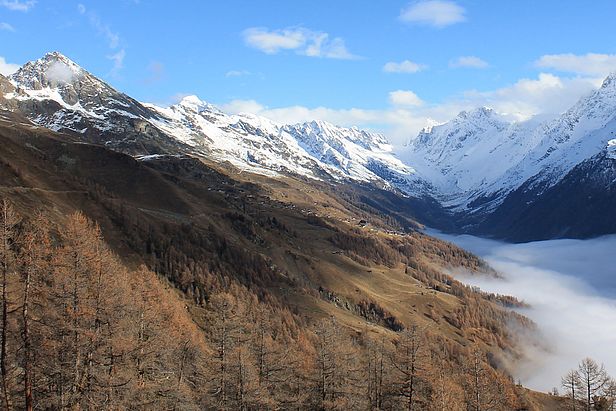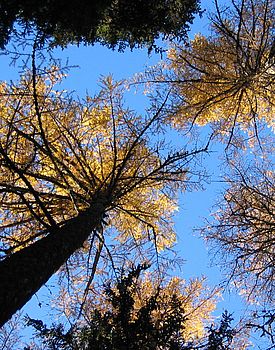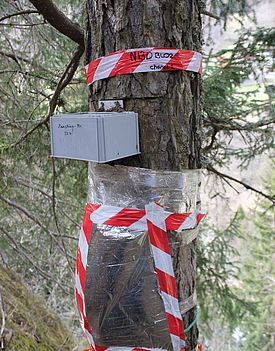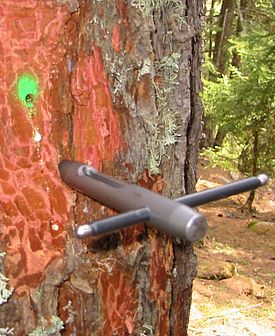22.10.2020 | Reinhard Lässig | News WSL
Until now, science has assumed that the amount of carbon formed in needles is the sole driving force for wood growth in coniferous trees. An international research team led by the Swiss Federal Research Institute WSL has now discovered in the Lötschental (Canton Valais) that the level of water pressure in the trunk is also a decisive factor for growth.
A seven-year study into the growth development of larches and spruces near Ferden in the Lötschental (canton of Valais) has shown, for the first time, that trees only form wood in their growth layer (cambium) if the water pressure in these cells is high enough. If it is too low, new wood cells cannot form, even if the tree has a sufficient supply of carbon. This is the conclusion reached by a WSL team working with research partners from Belgium, France, Spain and the USA.
Which is more important, light or water?
Trees in well-watered locations form more wood than those in places where the soil has dried out faster or that have received less precipitation. Prior to the study, the scientists had expected to see more growth in dry locations due to the additional sunlight.
To explain this surprising observation, the WSL researchers set up test areas at various altitudes on shady north-facing slopes and sunlit south-facing slopes and then examined the wood growth of spruces and larches each week. They took fresh microcore samples from the growth zone of around 40 softwood trunks. In addition, a plethora of measuring devices and sensors continuously recorded data from the soil as well as precipitation and air temperature. Last but not least, the team measured how much water the trees transpired.
"This study is the first to accurately measure the wood growth of mature trees growing in a natural environment every week over such a long period," says WSL's Richard Peters, the lead author of an article published recently in the journal New Phytologist. "This experiment offered a unique opportunity to describe the role of water shortage as a limiting growth factor," explains the tree physiologist.
Wood mass may increase less than expected
The researchers' work is important for assessing the impacts of global climate change on wood growth. Previous studies on wood growth have mainly focused on the effect of carbon absorbed during photosynthesis.(see footnote) In future, greater account will need to be taken of trees' water supply and the water pressure in the wood, because if climate change results in drier summers, this will also affect the water pressure and thus the trunk growth. Global estimates of wood growth in forests would therefore have to be revised downwards.
For example, if the average temperature were to increase by around 3 degrees Celsius by 2050, then the summer growth phase for spruce and larch, assuming precipitation remained the same, would be around 18 days shorter than at locations with more water, simply due to the loss of water pressure. In other words, a shortage of water reduces annual wood growth.
"As yet, we don't know what happens to the newly formed carbon in the trees during dry phases and when the water pressure is low," says study leader Patrick Fonti (WSL). Based on the data collected so far, further investigations in the Lötschental could shed more light on the uncertainties surrounding tree growth.
Footnote: Put simply, during photosynthesis, the green pigment chlorophyll in the needles and leaves of plants converts water and carbon dioxide into sugar (carbon) and oxygen with the help of sunlight.
Contact ¶
Links ¶
Scientific publication
Turgor – a limiting factor for radial growth in mature conifers along an elevational gradient. Peters RL, Steppe K, Cuny HE, De Pauw DJW, Frank DC, Schaub M, Rathgeber CBK, Cabon A, Fonti P. New Phytologist (2020), first published online: 13 August 2020. https://doi.org/10.1111/nph.16872
Links
The Lötschental tree-growth monitoring transect
Watching wood grow. WSL magazine Diagonal 1/2020
Copyright ¶
WSL and SLF provide the artwork for imaging of press articles relating to this media release for free. Transferring and saving the images in image databases and saving of images by third parties is not allowed.




